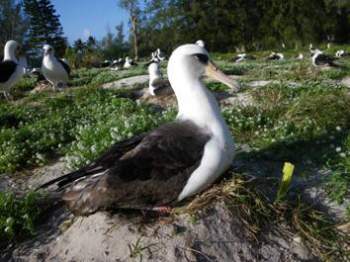U.S. Fish & Wildlife Service officials have now revised markedly upwards their earlier estimates (click here) of wildlife losses at Midway Atoll National Wildlife Refuge, Papahânaumokuâkea Marine National Monument, following the tsunami that washed over the Refuge's three low-lying islands during the night of 10/11 March 2011, that itself followed a massive earthquake off the east coast of Japan.
Surveys of the Refuge now reveal that more than 110 000 Laysan Phoebastria immutabilis and Black-footed Albatross P. nigripes chicks - about 22% of this year's albatross production on the island - were lost as a result of the tsunami and two severe winter storms that preceded it in January and February (click here).
At least 2000 adults were also killed. It is unknown what proportion of each species is represented in this total, but given the propensity for Black-footed Albatrosses to breed on the perimeter of the atoll the impact on their population may well be proportionally higher than that for Laysan Albatrosses.
The Refuge has recently become known for its two "celebrity" albatrosses: 'Wisdom', perhaps the oldest confirmed wild bird in the world, and the Short-tailed Albatross chick on Midway's Eastern Island, which was the first of its kind ever confirmed to be hatched outside of Japan (click here).
Wisdom, the 60-year-old albatross that recently hatched a chick (click here), was initially reported as surviving the event because her nest site was not over-washed, but biologists have not as yet been able to confirm her survival. However, there is a good chance she is out at sea provisioning for her growing chick and her nest site will be monitored closely to determine whether she has survived.

The Short-tailed Albatross chick was washed approximately 30 m from its nest, but was later safely returned by Refuge biologists. This chick's parents, however, have not been seen since the tsunami (they may also have been be at sea when the tsunami hit). Because the chick is incapable of fending for itself, Refuge staff will carefully consider whether hand-rearing would be appropriate if it is determined that it is no longer being fed by its parents.
Midway Atoll is comprised of three islands (Sand, Eastern and Spit) within an outer reef of approximately eight kilometres in diameter. Following the earthquake, the three islands were pounded by four successive waves, the tallest of which was approximately 1.5 m high. The tsunami over-washed the fringing reef and Spit Island completely, and covered approximately 60% of Eastern Island and 20% of Sand Island. For comparison, in early January, Spit Island held 1498 Laysan and 22 Black-footed albatross nests. After losses from the 14 January and 11 February storms and from the March tsunami, only four albatross chicks remain on Spit.
Midway biologists also initially estimated that thousands of Bonin Petrels Pterodroma hyopoleuca were lost, but they have since been unable to confirm a more accurate number due to the species' behaviour of breeding underground. Their burrows are not as extensively mapped as are the albatross nests. A few deaths of other adult seabirds were also reported, including Red-tailed Tropicbirds Phaethon rubricauda, Red-footed Boobies Sula sula and Great Frigatebirds Fregata minor.
The death toll is likely to continue to rise for both albatross species as many of the surviving chicks were moved great distances from their nest bowls, which will make it difficult for their parents to find and feed them. It will thus likely be some months before the true impact of the tsunami on Midway becomes known.
Tsunami images from Midway Atoll National Wildlife Refuge and Laysan Island are available for viewing at http://www.flickr.com/photos/usfwspacific/collections/72157626288933504/.
The above account has been summarized and adapted from a USFWS news release.
Lindsay Young, ACAP North Pacific News Correspondent 21 March 2011

 Français
Français  English
English  Español
Español